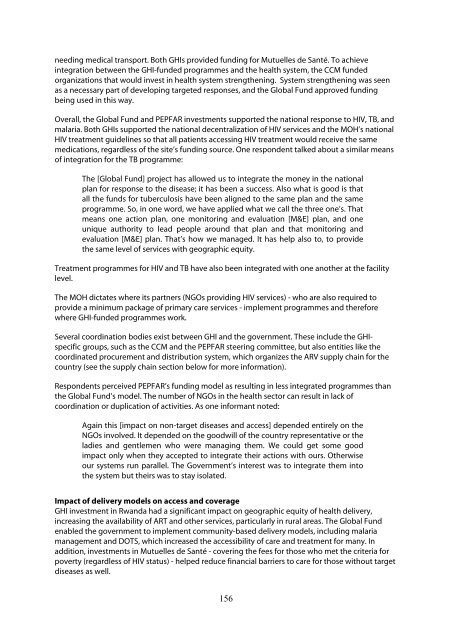MAXIMIZING POSITIVE SYNERGIES - World Health Organization
MAXIMIZING POSITIVE SYNERGIES - World Health Organization
MAXIMIZING POSITIVE SYNERGIES - World Health Organization
Create successful ePaper yourself
Turn your PDF publications into a flip-book with our unique Google optimized e-Paper software.
needing medical transport. Both GHIs provided funding for Mutuelles de Santé. To achieve<br />
integration between the GHI-funded programmes and the health system, the CCM funded<br />
organizations that would invest in health system strengthening. System strengthening was seen<br />
as a necessary part of developing targeted responses, and the Global Fund approved funding<br />
being used in this way.<br />
Overall, the Global Fund and PEPFAR investments supported the national response to HIV, TB, and<br />
malaria. Both GHIs supported the national decentralization of HIV services and the MOH’s national<br />
HIV treatment guidelines so that all patients accessing HIV treatment would receive the same<br />
medications, regardless of the site’s funding source. One respondent talked about a similar means<br />
of integration for the TB programme:<br />
The [Global Fund] project has allowed us to integrate the money in the national<br />
plan for response to the disease; it has been a success. Also what is good is that<br />
all the funds for tuberculosis have been aligned to the same plan and the same<br />
programme. So, in one word, we have applied what we call the three one’s. That<br />
means one action plan, one monitoring and evaluation [M&E] plan, and one<br />
unique authority to lead people around that plan and that monitoring and<br />
evaluation [M&E] plan. That’s how we managed. It has help also to, to provide<br />
the same level of services with geographic equity.<br />
Treatment programmes for HIV and TB have also been integrated with one another at the facility<br />
level.<br />
The MOH dictates where its partners (NGOs providing HIV services) - who are also required to<br />
provide a minimum package of primary care services - implement programmes and therefore<br />
where GHI-funded programmes work.<br />
Several coordination bodies exist between GHI and the government. These include the GHIspecific<br />
groups, such as the CCM and the PEPFAR steering committee, but also entities like the<br />
coordinated procurement and distribution system, which organizes the ARV supply chain for the<br />
country (see the supply chain section below for more information).<br />
Respondents perceived PEPFAR’s funding model as resulting in less integrated programmes than<br />
the Global Fund’s model. The number of NGOs in the health sector can result in lack of<br />
coordination or duplication of activities. As one informant noted:<br />
Again this [impact on non-target diseases and access] depended entirely on the<br />
NGOs involved. It depended on the goodwill of the country representative or the<br />
ladies and gentlemen who were managing them. We could get some good<br />
impact only when they accepted to integrate their actions with ours. Otherwise<br />
our systems run parallel. The Government’s interest was to integrate them into<br />
the system but theirs was to stay isolated.<br />
Impact of delivery models on access and coverage<br />
GHI investment in Rwanda had a significant impact on geographic equity of health delivery,<br />
increasing the availability of ART and other services, particularly in rural areas. The Global Fund<br />
enabled the government to implement community-based delivery models, including malaria<br />
management and DOTS, which increased the accessibility of care and treatment for many. In<br />
addition, investments in Mutuelles de Santé - covering the fees for those who met the criteria for<br />
poverty (regardless of HIV status) - helped reduce financial barriers to care for those without target<br />
diseases as well.<br />
156

















